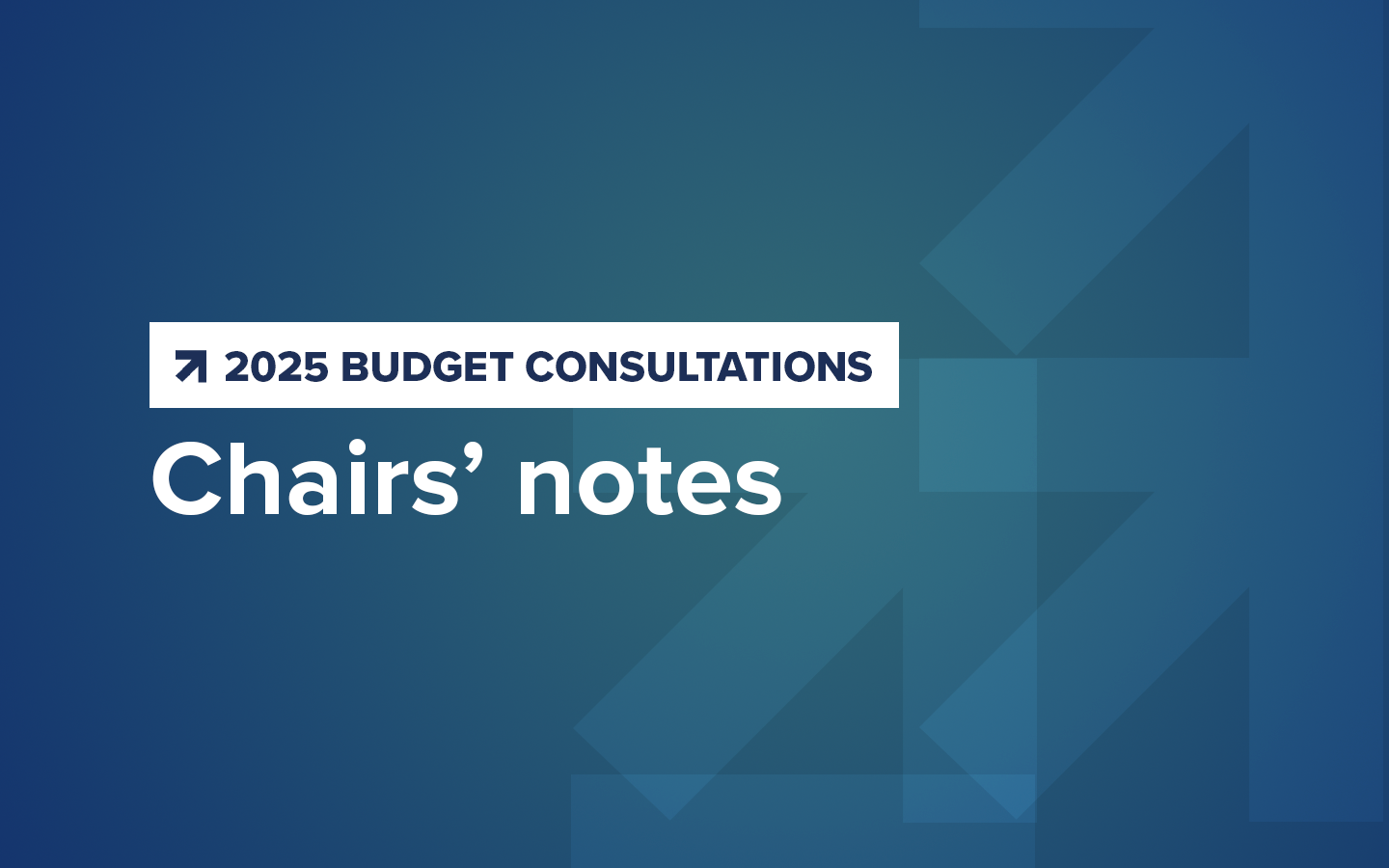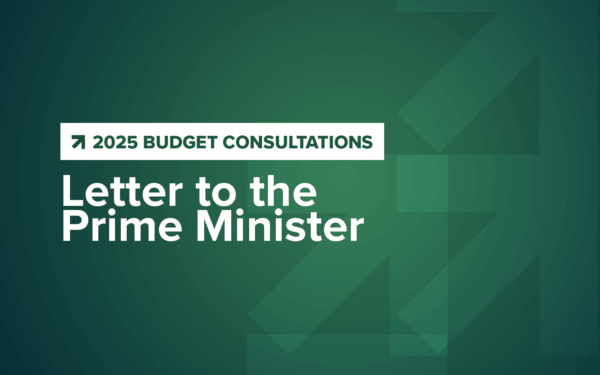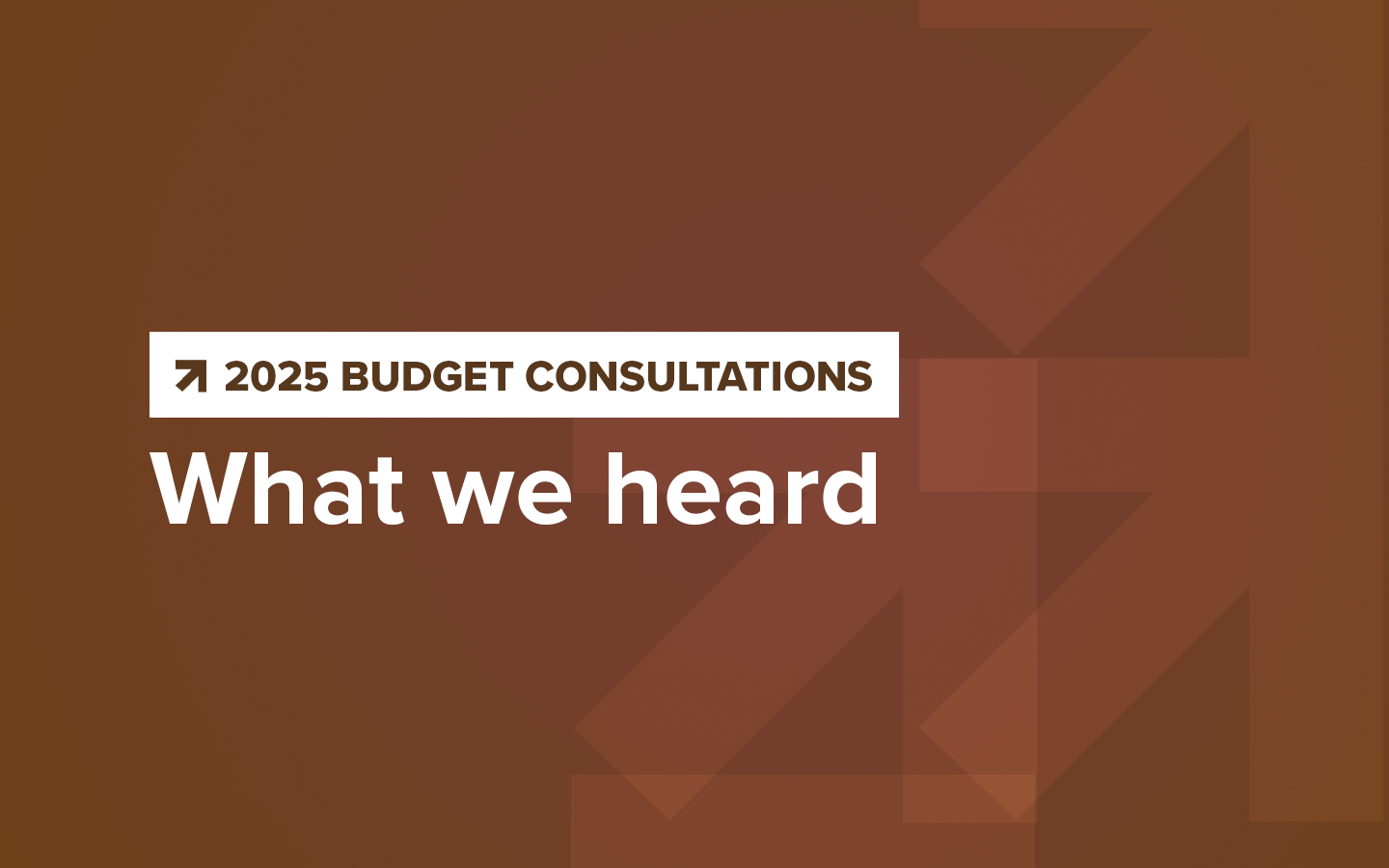Chairs’ notes
2025 Budget Consultations
Introduction
In anticipation of a consequential fall federal budget, the Business Council of Canada (BCC) conducted an extensive consultation on the future of the country’s fiscal policy. Taken together, the findings provide a comprehensive snapshot of how Canada’s most engaged economic stakeholders view the state of federal public finances, the role of fiscal anchors, the balance between investment and restraint, and the steps needed to restore credibility in fiscal management.
The consultations were co-chaired by Theo Argitis, BCC senior vice-president of policy, and Serge Dupont, senior advisor and head of the Public Policy Group at Bennett Jones. The process brought together the voices of more than 50 of the country’s chief executives and nearly 20 respected economists, investors and former senior officials through a detailed expert questionnaire and a series of in-depth interviews.
In sum, the consultations call for growth-based budget management that is anchored in discipline and credibility. That means ensuring the fiscal plan remains sustainable and addresses the nation’s core structural challenges of lagging productivity and declining investment.
Although participants offered a wide diversity of views, their combined feedback points to a convergence on the following key principles:
A difficult starting point.
Canada’s fiscal starting point is fragile, though not a crisis. Stakeholders agree that structural deficits are entrenched, interest costs are rising, and long-term spending pressures—from defence to health care—are mounting. They also agree that Canada still enjoys the trust of markets and retains fiscal capacity, but that credibility has been eroded in recent years and cannot be taken as a given. The overriding call is for a clear, credible, and transparent fiscal framework.
A credible plan
While there is a plenty of debate over the “right” anchors and targets to guide fiscal policy, there is wider consensus around the following principles. The federal government should:
1. Adopt a dashboard of metrics and guidelines that shows a sustainable track over the medium term even under stress-tested scenarios. No one anchor tells the full fiscal story. For most, “sustainable” means a “contain and reduce” approach to Canada’s deficit and debt burdens.
2. Ensure guardrails are practical from a government operations perspective and translate into actual real constraints.
3. Design a fiscal framework that is growth-enhancing and supportive of investment, both public and private.
4. Ensure that anchors aren’t easily abandoned and the framework is binding on the government. This is where credibility is won and lost.
The pure “balanced budget” message no longer commands the consensus it once did. Many respondents support targeted, up-front investments and government efforts to de-risk major projects. There is broad agreement that within the frame of wider tax reform, taxes on investment should be cut to attract capital. Public borrowing for vital investments that generate an economic return can be endorsed without abandoning Canada’s reputation for prudence.
At the same time, a credible and sustainable fiscal plan is critical to maintaining investor confidence in the economy. A fiscal plan must not only prevent further long-term deterioration but also repair damage from recent years.
Any new deficit financing needs to come with a key condition: borrowed funds must be directed exclusively toward economy-enhancing initiatives like trade infrastructure, defence modernization and initiatives that boost investment in the economy. There is no tolerance for borrowing for additional discretionary spending.
The proposal to formally separate the budget into “operating” and “capital” accounts has some supporters. But the plurality view it as vulnerable to abuse. If government adopts an operating/capital split, it must publish clear definitions and enforcement mechanisms that prevent relabelling or political gaming.
The best way to build credibility is to be clear about trade-offs and to set a medium-term consolidation track that is easily understood and operationalized by ministers and the public service.
A dashboard, not a single anchor
There is an overwhelming, near-unanimous demand for credible fiscal anchors to instill political discipline. Anchors are valued for their ability to signal discipline, structure trade-offs within government, and communicate fiscal direction to markets and the public.
However, both BCC members and experts reject simplistic rules, strongly favouring a dashboard approach that provides a complete view of fiscal health, rather than judging a budget based on one fiscal anchor. Members strongly preferred a combination of rules rather than a single one based on any individual metric.
Some measures, like debt-to-GDP, are key gauges of sustainability over the medium term but do not serve as effective day-to-day constraints. What matters most for discipline inside government are rules that influence decisions on a one- to two-year horizon.
Well-designed frameworks would combine a long-term sustainability anchor (like declining gross debt-to-GDP) with operational rules (like an expenditure cap or a deficit reduction target), while monitoring early-warning indicators (such as interest-to-revenue ratios or interest-to-GDP.)
Other practical rules with clear accountability include:
- Publishing and meeting absolute deficit-reduction paths, with meaningful reductions over the medium term.
- Keeping program-spending growth below nominal GDP over the medium-term.
- Requiring that any new permanent spending be permanently financed through offsetting savings or revenue.
- Borrowing only for productivity-raising initiatives, including defence where projects meet a clear strategic or economic return.
History shows hard targets work best over short-term horizons. To bring Canada’s finances under control in the mid-1990s, Paul Martin adopted two-year horizons for his hard fiscal targets, including a pledge in his first budget in 1994 to halve the deficit as a share of GDP by 1996. At the G20 summit in Toronto in 2010, just after the global recession, Prime Minister Stephen Harper led a group of advanced economies to commit to halving their deficits over three years.
While net debt is often cited by the government as its preferred measure, gross debt also requires close attention. Borrowing for investment raises gross debt, and it is gross debt that must be raised in the market and then serviced. Debt-financed investment must generate a positive return in order not to burden future generations of taxpayers.
Structural reforms
There is a broad consensus that the path to long-term sustainability runs through deep structural reform.
This includes an immediate and rigorous program review and a clear mandate for comprehensive tax reform aimed at simplifying the tax code and shifting the burden away from investment. There is no path to fiscal sustainability unless Canada resolves its growth challenges.
The program review should be modeled on the 1990s exercise, grounded in first principles about whether there is a federal role in every space in which the government currently operates. There is a broad agreement that the deficit is also a symptom of a larger issue: a federal government that has grown too large and inefficient, expanding beyond its core functions. To sustain a vibrant private sector, government must constrain its footprint and return to first principles to justify interventions. This will also force more explicit policy trade-offs. Transfers to persons and to other levels of government should not be excluded from a review.
Almost all economists and executives surveyed believe a tax reform process is needed to simplify the system, remove boutique credits, and shift the burden away from investment to encourage capital formation.
Canada will also need a robust national savings rate to finance investment in a more constrained global environment where capital may be harder to find. Some respondents suggest adopting economy-wide growth or investment targets as aspirational accountability devices, to keep attention on outcomes and reinforce an investment-first lens.
Survey methodology
We undertook the consultation from Aug. 4 to Sept. 24.
We combined (i) a structured survey of economists, policy experts, former senior officials and market practitioners; (ii) semi-structured interviews with many of the same experts (some interview-only); (iii) a shorter survey of BCC members; and (iv) follow-up interviews with some BCC members.
We received responses from 18 experts.
Their responses segmented into overlapping clusters:
- Those who emphasize discipline, enforceable anchors, and execution risk inside government.
- Those who were comfortable with measured near-term deficits if a credible medium-term plan exists.
- Those who highlighted competitiveness, tax architecture, regulatory drag; see deficits as symptoms.
Why This Consultation, Why Now
The BCC has long championed sound fiscal stewardship, grounded in spending discipline, credible anchors and a commitment to balanced budgets over time. But the policy landscape is shifting.
Global protectionism and economic nationalism are reshaping the world around us and testing Canada’s sovereignty and resilience. Our trading relationship with the U.S. is teetering. Governments globally are responding to new imperatives — including national security and growing competition for private capital.
Many countries, including the U.S., are using fiscal levers in aggressive ways to gain a competitive advantage on others. Prime Minister Mark Carney has been clear he too intends to use the nation’s balance sheet to support growth and foster investment, and indicated he plans to sustain structural deficits indefinitely for the purpose.
Given the extraordinary circumstances that we live in, and the path the government appears to be intent on taking, we felt it was the right time to assess the extent to which our own positioning on the issue should evolve in response.
The BCC’s objective is practical and focused: identify the fiscal conditions that are optimal in catalyzing investment, bolstering our resilience and maximizing our economic prosperity.
Fundamentally, we believe that unleashing private sector investment and enterprise is the most effective way to do this.
And we cannot simply borrow our way to an investment-led recovery. Canada must protect the macro environment for investment—and do so under rules that markets believe.
Without a credible fiscal policy, interest rates will rise across the economy and crowd out private activity, which in turn will backfire by narrowing fiscal room just when it’s most needed. And let’s not forget, fiscally challenged governments are also more likely to raise taxes, creating a source of uncertainty for business.
But we also acknowledge that in some instances, it may make sense to use the government’s balance sheet to support growth. For example, direct investment in trade-enabling infrastructure—ports, rail, grid expansion, water and digital networks—can drive productivity and provide positive spillovers that raise the return on private projects. And the country desperately needs lower taxes on investment and capital.
We want to thank the chief executives and experts who contributed to the process, including:
Randall Bartlett, Desjardins Group
Paul Beaudry, UBC
Ed Devlin, Devlin Capital
David Dodge, former Bank of Canada Governor
Don Drummond, Queen’s University
Simon Kennedy, Deputy Minister of Industry (retired)
Kevin Page, IFSD
Jean-Francois Perrault, Scotiabank
Doug Porter, BMO
Lawrence Schembri, Fraser Institute
Avery Shenfeld, CIBC
Sean Speer, The Hub
Andrew Spence, Spence Strategic Consulting
Trevor Tombe, University of Calgary
Carolyn Wilkins, Princeton University.
Some individuals participated on condition of anonymity.










